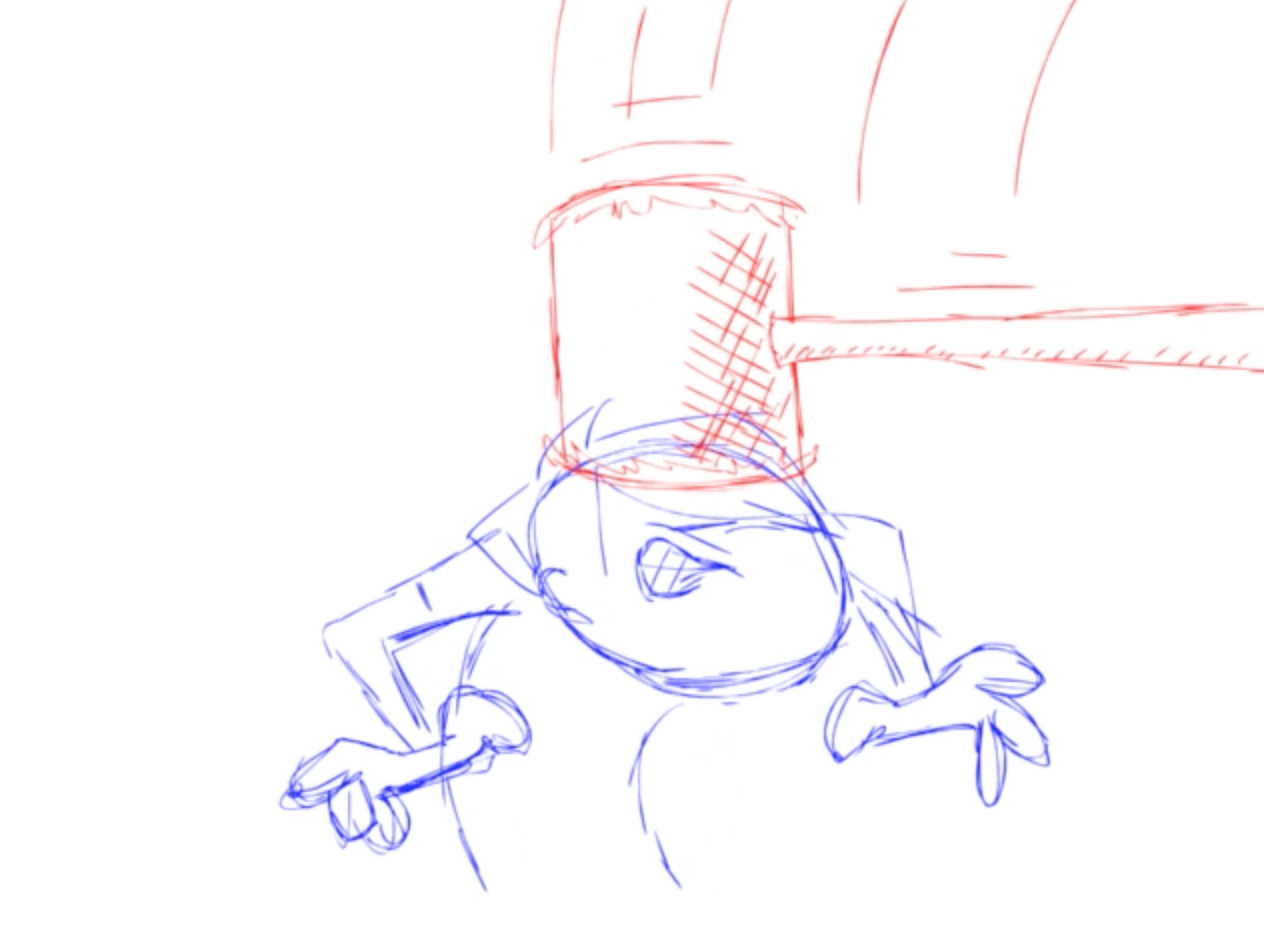Timing, timing and…(wait for it)…timing.
by
At any one moment your animation involves a plethora of principals piled atop one another like a family of furry possums holed up and huddled for warmth. Sorting through this mess of real-world mechanics and virtual-world technical issues to separate one principal from another seems nearly impossible. They all depend on each other so much. But of course there are two principals that set the stage for them all: spacing and timing.
The abstract concepts of spacing and timing are tricky to comprehend at first glance. At least they were for me. I remember really having my wires crossed during my early attempts to animate. The idea of how spacing related to acceleration and deceleration would come out completely backwards – tightening my spacing in order to make things go faster; wider for slower. Ugh! The frustration felt similar to the kind I feel when I confuse the relative direction of right and left (which I do far too often.) But once I drilled it in to my head, my use of spacing corrected itself and was never really a huge problem again.
Timing I never had a problem with at all. The amount of time an action (or reaction) took to happen within a particular range of frames easily translated for me. I’ve lived so long in the world of timing – in both music and performance – that knowing how to divide my frames in to rhythmically interesting shapes, or how to get a laugh or a gasp or whatever, feels much more natural to me.
But not all timing is created equal. And when people ask my thoughts on the mysteries of timing, I always want to make sure to describe how I separate them in my mind. The categories are not that unusual, but they are worth illustrating.
First, there is mechanical timing; or the frame range in which you choose to distribute a particular set of drawings. The amount of time a physical body takes to accelerate or decelerate is directly responsible for communicating a feeling of weight. In other words, how far apart your drawings are (spacing) during a specific number of frames (timing) can describe the weight of an object at any one moment in an animated scene. This is just the basic mechanics of movement you learn to communicate early in your studies, and hopefully tattoo in to your subconscious for the rest of your animation career, to be used as easily as you use language. (Ha! Right!)
Another type of timing, for me, is my overall phrasing*; or the varied rhythms I choose to help communicate or exaggerate the emotion behind the force of a body, as well as create an engaging and visually interesting scene. This is very musical for me, just like the dynamics of melody or the arrangement of a song. Any good singer, speaker, actor or dancer uses an instinctive sense of phrasing to guide (almost lure) their audience through a performance; letting them rise and rest with the varied energies in their voice or body; keeping us interested, engaged, expectant and curious. A good musician can take control of your breathing. A good dancer can make you tense and release your muscles in sympathy with their own. A good comedian can coax you in to a sense of intimacy, only to surprise you with their punchline. Which leads me to my last category… Comedic or dramatic timing.
This most sophisticated use of timing – comedic/dramatic timing – employs the purposeful manipulation of an audience’s expectations to produce a spontaneous response; like bursts of laughter, tears of joy (or sadness), screams of fear or surprise, etc. I think comedic/dramatic timing is what people are asking about when they wonder about the secrets of good timing. Although it may be hard to execute, I find it the easiest to explain. Easy because it’s all about one thing: expectation. What does your audience expect to happen right at that moment, or in the very next moment? and are you going to fulfill or defy that expectation? And most importantly, when?
Here’s some different ways you could interpret the comedic timing in a piece of physical comedy.. (And I’m going to work in animatic form, because I believe good story artists are natural timing experts.)
Lets use a very cliché example of a head bonk.
The actual impact is almost always by its nature a surprise, so in these examples we’ll just deal with the response to the bonk.
Here a response your audience might expect:
If your audience consists of small children, their relatively narrow life experience makes their list of expectations rather small. Because of that, almost anything the character does would be a surprise and probably get a big laugh. Especially if its big and silly. The older your audience gets, however, the wider their life experience is, and their ability to predict what might happen in response to the head bonk is much greater. It is simply more difficult to surprise a more sophisticated audience, so a performer (or animated performance) has to work harder to surpass their expectations.
Here’s only a slightly more surprising response:
Sometimes, if you work even harder you can get an even bigger laugh. Here’s a surprise that goes beyond what they might expect to be surprised by:
Sometimes you have to work so hard as to create an emotional decoy, something that sends the audience’s expectations down a different path before you surprise them. this is often called a “mis-lead.” Here’s an example of a purposeful mis-lead:
Another (and I’d argue slightly more difficult) way to defy your audience’s expectations is to go for the completely unrelated or illogical surprise – the absurd (for my British friends.):
Heck, you can even simply wait so long before having your character react at all that your audience has exhausted their mental list of expectations right at the moment that you give them something. A classic deadpan with a “wait for it” gag at the end (with a little “mis-lead” for flavor):
Of course the possibilities are limitless, and this is just a simple gag. These ideas can translate to the most sophisticated humor or the most mundane situational comedy. Laugher is an automatic response, kind of like a reflex. While there are infinite permutations of this concept that will trigger this reflex, the core idea is always the same: what does your audience expect right at this moment? And what will you do in fulfilling or defying that expectation to get the response you want?
Dramatic performances can of course make use of an audience’s expectations by holding back on the emotional gas pedal; or even totally fulfilling their expectation but taking it a bit further than they may have imagined much sooner than they may expect. The boundaries of catharsis can be pushed through the use of well controlled dramatic timing, for sure. Melodrama, on the other hand, or predictable and over-done drama, is a result of poor timing and in-artful manipulation of your audience’s expectations. But, if you push that melodrama toward the absurd you could get a nice big laugh.
I’m a stand up comedy junkie. I love watching good comedians (and bad) and taking note of their use of poses and timing to set themselves up for a good punch line. But, if you enjoy it as much as I do, listen closer next time and notice how far each one of their laugh lines defies your expectations and the timing they used to deliver it. How many steps beyond your expectations do they go? It’s a science, I swear. Some lucky bastards are born with that part of their brain already cooking, but the rest of us have to study and learn. Timing, especially in animation, is something you can tweak and refine to perfection as you practice. If you are 2-weeks in on a scene and it is still making you laugh, cry, smile, whatever – you’re doing ok.
/ken
Ps. I’m going to follow this post up with a podcast demonstrating how pushing the use of muscle tension, either full-body or isolated, can really enhance your physical comedy timing.
*(Phrasing is a rather nebulous concept too. But, for anyone who has watched my videos, you have heard me talk about it quite enough, I am sure. So I’ll spare you the repetition.) 😉



Great stuff Ken…thanks for sharing
Thanks JP! And thanks for the link! 🙂
Wow!, that’s gold Ken!
I think I handle better spacing than timing. I usually get a correct timing but I kind of feel it could be much better. After reading your post it made rethink the shot I’m animating at home and try to push it and make it funnier.
Never made that difference between types of timings but it makes perfectly sense.
“Your audience expectations” is something I’m going to think about it a lot from now on when animating humor 🙂
Keep up the good work, we really appreciate it.
I’m glad it was helpful, Martin! It’s a really fun exercise to make a list of all the possible options that can happen in a scene, then pick the one(s) that make me laugh the most. This really only is the tip of the iceberg. It’s like an animator’s form of improv. (and, I really wanted an excuse to animate a guy getting hit in the head by a big hammer.) 😉 Thanks man!